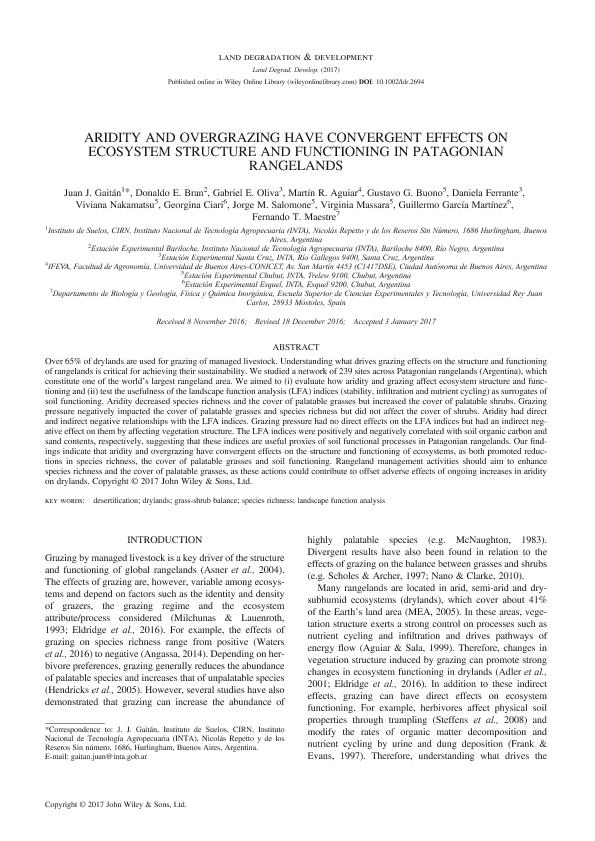Mostrar el registro sencillo del ítem
dc.contributor.author
Gaitán, Juan José

dc.contributor.author
Bran, Donaldo Eduardo

dc.contributor.author
Oliva, Gabriel Esteban

dc.contributor.author
Aguiar, Martin Roberto

dc.contributor.author
Buono, Gustavo Gabriel
dc.contributor.author
Ferrante, Daniela

dc.contributor.author
Nakamatsu, Viviana
dc.contributor.author
Ciari, Georgina
dc.contributor.author
Salomone, Jorge M.
dc.contributor.author
Massara, Virginia
dc.contributor.author
García Martínez, Guillermo Carlos

dc.contributor.author
Maestre, Fernando T.
dc.date.available
2018-07-06T15:52:24Z
dc.date.issued
2018-02
dc.identifier.citation
Gaitán, Juan José; Bran, Donaldo Eduardo; Oliva, Gabriel Esteban; Aguiar, Martin Roberto; Buono, Gustavo Gabriel; et al.; Aridity and Overgrazing Have Convergent Effects on Ecosystem Structure and Functioning in Patagonian Rangelands; John Wiley & Sons Ltd; Land Degradation & Development; 29; 2; 2-2018; 210-218
dc.identifier.issn
1085-3278
dc.identifier.uri
http://hdl.handle.net/11336/51495
dc.description.abstract
Over 65% of drylands are used for grazing of managed livestock. Understanding what drives grazing effects on the structure and functioning of rangelands is critical for achieving their sustainability. We studied a network of 239 sites across Patagonian rangelands (Argentina), which constitute one of the world's largest rangeland area. We aimed to (i) evaluate how aridity and grazing affect ecosystem structure and functioning and (ii) test the usefulness of the landscape function analysis (LFA) indices (stability, infiltration and nutrient cycling) as surrogates of soil functioning. Aridity decreased species richness and the cover of palatable grasses but increased the cover of palatable shrubs. Grazing pressure negatively impacted the cover of palatable grasses and species richness but did not affect the cover of shrubs. Aridity had direct and indirect negative relationships with the LFA indices. Grazing pressure had no direct effects on the LFA indices but had an indirect negative effect on them by affecting vegetation structure. The LFA indices were positively and negatively correlated with soil organic carbon and sand contents, respectively, suggesting that these indices are useful proxies of soil functional processes in Patagonian rangelands. Our findings indicate that aridity and overgrazing have convergent effects on the structure and functioning of ecosystems, as both promoted reductions in species richness, the cover of palatable grasses and soil functioning. Rangeland management activities should aim to enhance species richness and the cover of palatable grasses, as these actions could contribute to offset adverse effects of ongoing increases in aridity on drylands. Copyright © 2017 John Wiley & Sons, Ltd.
dc.format
application/pdf
dc.language.iso
eng
dc.publisher
John Wiley & Sons Ltd

dc.rights
info:eu-repo/semantics/openAccess
dc.rights.uri
https://creativecommons.org/licenses/by-nc-sa/2.5/ar/
dc.subject
Desertification
dc.subject
Drylands
dc.subject
Grass-Shrub Balance
dc.subject
Landscape Function Analysis
dc.subject
Species Richness
dc.subject.classification
Otras Ciencias Biológicas

dc.subject.classification
Ciencias Biológicas

dc.subject.classification
CIENCIAS NATURALES Y EXACTAS

dc.title
Aridity and Overgrazing Have Convergent Effects on Ecosystem Structure and Functioning in Patagonian Rangelands
dc.type
info:eu-repo/semantics/article
dc.type
info:ar-repo/semantics/artículo
dc.type
info:eu-repo/semantics/publishedVersion
dc.date.updated
2018-06-19T15:58:53Z
dc.journal.volume
29
dc.journal.number
2
dc.journal.pagination
210-218
dc.journal.pais
Reino Unido

dc.journal.ciudad
Londres
dc.description.fil
Fil: Gaitán, Juan José. Consejo Nacional de Investigaciones Científicas y Técnicas; Argentina. Instituto Nacional de Tecnología Agropecuaria. Centro de Investigación de Recursos Naturales. Instituto de Suelos; Argentina
dc.description.fil
Fil: Bran, Donaldo Eduardo. Instituto Nacional de Tecnología Agropecuaria; Argentina
dc.description.fil
Fil: Oliva, Gabriel Esteban. Instituto Nacional de Tecnología Agropecuaria; Argentina
dc.description.fil
Fil: Aguiar, Martin Roberto. Consejo Nacional de Investigaciones Científicas y Técnicas. Oficina de Coordinación Administrativa Parque Centenario. Instituto de Investigaciones Fisiológicas y Ecológicas Vinculadas a la Agricultura. Universidad de Buenos Aires. Facultad de Agronomía. ; Argentina
dc.description.fil
Fil: Buono, Gustavo Gabriel. Consejo Nacional de Investigaciones Científicas y Técnicas; Argentina. Instituto Nacional de Tecnología Agropecuaria; Argentina
dc.description.fil
Fil: Ferrante, Daniela. Instituto Nacional de Tecnología Agropecuaria; Argentina
dc.description.fil
Fil: Nakamatsu, Viviana. Instituto Nacional de Tecnología Agropecuaria; Argentina
dc.description.fil
Fil: Ciari, Georgina. Instituto Nacional de Tecnología Agropecuaria; Argentina
dc.description.fil
Fil: Salomone, Jorge M.. Instituto Nacional de Tecnología Agropecuaria; Argentina
dc.description.fil
Fil: Massara, Virginia. Instituto Nacional de Tecnología Agropecuaria; Argentina
dc.description.fil
Fil: García Martínez, Guillermo Carlos. Instituto Nacional de Tecnología Agropecuaria; Argentina
dc.description.fil
Fil: Maestre, Fernando T.. Universidad Rey Juan Carlos; España
dc.journal.title
Land Degradation & Development

dc.relation.alternativeid
info:eu-repo/semantics/altIdentifier/doi/https://dx.doi.org/10.1002/ldr.2694
dc.relation.alternativeid
info:eu-repo/semantics/altIdentifier/url/https://onlinelibrary.wiley.com/doi/abs/10.1002/ldr.2694
Archivos asociados
